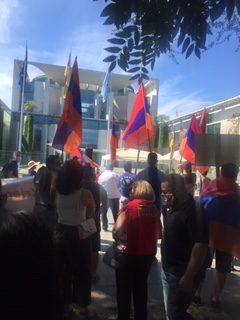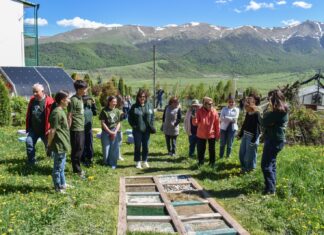BERLIN — “Make dolma not war.” That is the message that Haykanush Sechelyan transmitted on a poster during a demonstration in Hamburg, Germany on August 1.
A member of an Armenian youth group, she was one of many in several cities, who had come together to protest acts of violence against Armenians over the past ten days.
On July 23, an official car of the Armenian embassy was set ablaze in front of the diplomatic mission. In the days following, a taxi agency and an Armenian shisha bar in Cologne were attacked; according to eyewitness accounts, 30 men wearing black facemasks assaulted the site, throwing chairs and tables through the glass windows before fleeing. All signs indicated that Azerbaijanis were behind the acts of violence, which came in parallel to Turkish-Azerbaijani military maneuvers on the Armenian border and escalated aggression by Azerbaijan.
The Central Council of Armenians in Germany (ZAD) issued a call on July 31, denouncing these and other acts of violence, and called for a demonstration in the German capital. In light of the escalating military conflict, the ZAD warned that Azerbaijani forces would transport the violence to German soil. In addition to the arson and vandalism, Armenians in Germany had been targeted with hate mail and threatening phone calls. “After such developments, one must ask the question: How secure is life for Armenians today in Germany?” asked the ZAD. The press release called on the German government to act, by “reinforcing the peace process and by suspending arms exports to Baku and Ankara.” It demanded “an initiative on the part of the German Chancellor’s office and the Foreign Ministry to stop Azerbaijan and to guarantee the security of German-Armenians here.” Furthermore it demands “the Turkish President, who fuels the conflict and has already assured Baku his support, urge restraint. For the Armenophobia that President Erdogan has been nourishing, can become the fuse for unforeseeable events on German soil.” Over 30 Armenian organizations signed the call for a demonstration in front of the Chancellor’s office, to warn against the possible consequences that the escalation of tensions may have on “the peace process in the Caucasus, security in Europe and the security of Armenian associations in Germany.”
On Saturday, representatives of Armenian groups nationwide gathered in the German capital in a disciplined assembly. As Bea Ehlers-Kerbekian reported, it was more a political gathering than a demonstration. Speakers, who included Azat Ordukhanyan of the Armenian Academic Society 1860 (AAV 1860) and Gerayer Koutcharian of the Working Group for Recognition, Against Genocide, for Understanding among Peoples (AGA), sought to explain the events, provide an accurate account of the threats and acts of violence that had occurred, and demand political action in response. Both the German government and the European Union should intervene, cease arms deliveries, and engage in diplomatic moves to de-escalate in the region.
Responding through Art








